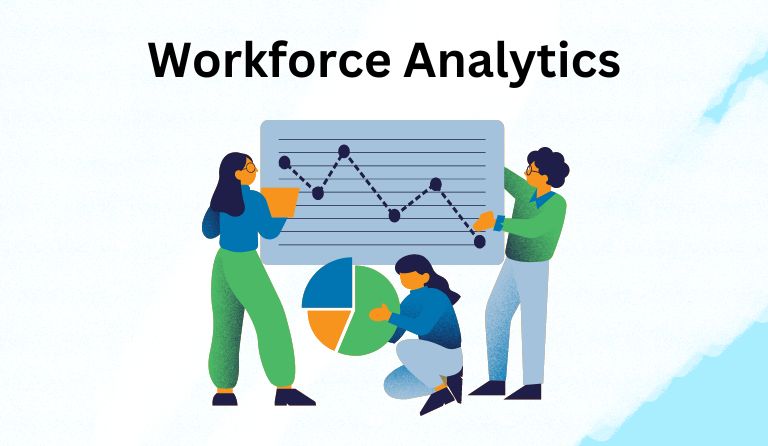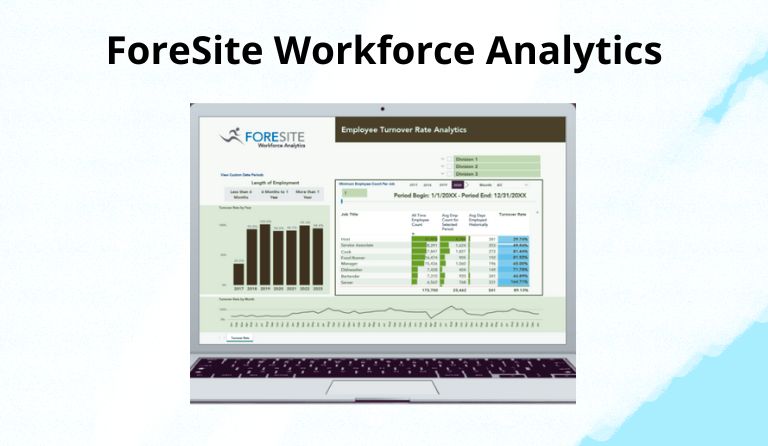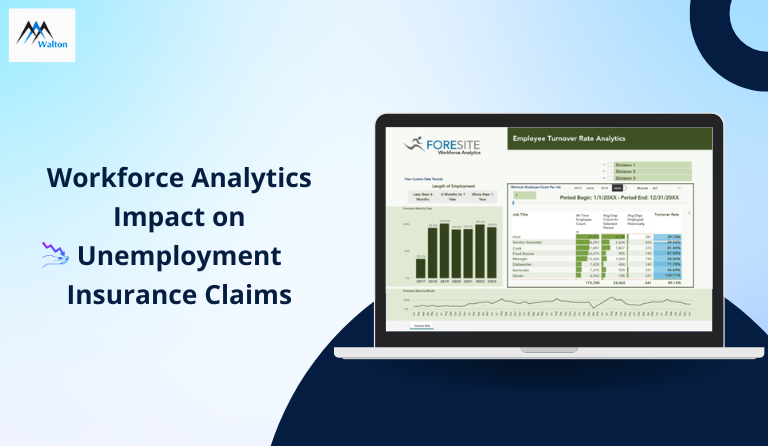Introduction
In today’s data-driven world, businesses are increasingly turning to workforce analytics to streamline operations and improve decision-making processes. One area where this shift is proving particularly impactful is in reducing Unemployment Insurance claims. These claims can result from layoffs, dismissals, or other workforce disruptions, often putting a significant financial strain on companies. Workforce analytics offers a powerful solution to this problem, enabling businesses to predict workforce trends, enhance workforce management, improve employee retention, and optimize hiring decisions.
What is Workforce Analytics?
Workforce analytics involves the use of data to analyze patterns and trends in employee behavior, performance, engagement, and workforce management. By collecting and examining this data, companies can gain valuable insights into their workforce, often enhanced by HR software, allowing them to make informed decisions about hiring, training, and managing employees.

This process typically involves tools and techniques such as artificial intelligence, machine learning, and data visualization, which help businesses identify key workforce metrics and anticipate potential issues. These insights empower organizations to take proactive steps, ensuring smoother workforce management and reducing the need for drastic actions like layoffs that may lead to employees having to claim unemployment insurance benefits.
What are the Common Causes of UI Claims?
- Layoffs due to poor business performance: When a company faces financial difficulties, it often results in layoffs, forcing employees to file for unemployment benefits.
- Terminations for misconduct or poor performance: Employees who are terminated for not meeting job expectations or engaging in misconduct may also file for unemployment, depending on the circumstances.
- Employees leaving jobs due to dissatisfaction or burnout: Workplace dissatisfaction, long hours, or unmanageable stress can lead to employees quitting and seeking unemployment insurance claims.
- Mismatched hiring, where employees’ skills or interests don’t align with their roles: Poor job placement can result in employees leaving early, leading to more frequent Unemployment Insurance claims.
- Early departures leading to subsequent Unemployment Insurance claims: When employees leave prematurely, whether voluntarily or involuntarily, it often results in claims for unemployment benefits.
Related Article: Unemployment Claims Management: A Burden or a Managed Expense?
How Workforce Analytics Reduces UI Claims?
1. Identifying At-Risk Employees
Workforce analytics can help employers identify employees who may be at risk of leaving. By analyzing factors like engagement scores, performance metrics, and even absenteeism patterns, companies can predict turnover and implement measures to retain top talent. For example, if an employee shows signs of disengagement, managers can intervene early with tailored solutions such as additional training or role changes, thus preventing resignations or terminations, and ultimately avoiding an unemployment insurance claim.
2. Optimizing Recruitment
Hiring the right person for the job is critical to reducing unemployment insurance claims. Workforce analytics can analyze vast amounts of data during the hiring process, ensuring that candidates not only fit the job description but also align with the company culture. This reduces the risk of early job termination due to poor job fit, lowering the chances of claiming unemployment insurance benefits.

3. Monitoring Employee Performance and Engagement
Another way workforce analytics reduces claims is by providing real-time data on employee performance and satisfaction. Regularly tracking these metrics allows businesses to identify when employees may be struggling or disengaged. By addressing performance issues early and offering support, companies can avoid dismissals, preventing the need for employees to claim unemployment insurance benefits.
4. Efficient Workforce Planning
Data-driven workforce planning allows companies to anticipate business needs and adjust staffing levels accordingly. This reduces the likelihood of overstaffing during slow periods, which can lead to layoffs and, consequently, Unemployment Insurance claims. Similarly, it helps prevent understaffing, which can burn out employees and lead to high turnover rates. By optimizing staffing decisions with data, companies can avoid the scenarios that often result in an unemployment insurance claim.
Related Article: Don’t Let Unemployment Claims Drain Your Business: A Guide to Cost Management
Workforce Analytics Case Studies
Several companies have already seen success in reducing Unemployment Insurance claims through the use of workforce analytics. For instance, a large retail chain used predictive analytics to identify employees who were at risk of leaving based on factors like attendance patterns and customer feedback. By addressing these issues proactively, the company was able to reduce employee turnover by 20% and saw a corresponding drop in unemployment insurance claims.
In another example, a manufacturing company integrated workforce analytics into its recruitment process. The company was able to hire candidates who were a better fit for long-term roles, leading to a 15% reduction in early terminations. As a result, unemployment claims dropped significantly, saving the company thousands of dollars annually in insurance costs.
What are the Challenges in Implementing Workforce Analytics?
Despite its advantages, implementing workforce analytics comes with challenges. A key obstacle is data privacy, as companies must responsibly manage employee data while adhering to regulatory requirements. Additionally, setting up the necessary infrastructure to collect, store, and analyze workforce data requires an investment in both technology and expertise.
Another challenge is cultural resistance. Some managers and employees may be skeptical of data-driven decision-making, fearing it could replace human judgment. Overcoming this requires clear communication about the goals of workforce analytics and workforce management and how it can benefit both the company and its employees.
Walton’s ForeSite Workforce Analytics Platform
One of the most effective HR analytics tools available to businesses looking to reduce unemployment insurance claims is the ForeSite Workforce Analytics Platform. This innovative platform leverages advanced data analytics to help companies make informed workforce decisions, reducing turnover and mitigating unemployment claims. ForeSite offers predictive insights that enable employers to track employee performance, engagement, and overall satisfaction, allowing for timely interventions before any workforce issues escalate.

The ForeSite Workforce Analytics platform includes several powerful features:
Predictive Turnover Models: ForeSite uses machine learning algorithms to identify employees who are at risk of leaving the company, allowing businesses to implement retention strategies, improve workforce management, and prevent the layoffs that often lead to unemployment insurance claims.
Real-Time Engagement Metrics: Employers can monitor employee engagement in real-time, making it easier to detect early signs of dissatisfaction or burnout. By proactively addressing these concerns, companies can avoid the costly claims that arise when employees are dismissed or resign.
Performance Optimization Tools: Foresite helps companies track productivity and performance metrics across the organization. By identifying underperforming areas, businesses can provide targeted support and coaching, preventing dismissals that may result in claims for unemployment insurance benefits.
Conclusion
HR software that incorporates workforce analytics is more than just a trend—it’s a critical tool for reducing unemployment insurance claims and improving overall business performance. By identifying at-risk employees, optimizing recruitment processes, and enhancing workforce planning, businesses can prevent the disruptions that lead to claims. By leveraging HR software like ForeSite, businesses can gain valuable insights into employee behavior, optimize recruitment processes, and enhance workforce management strategies.
Walton’s workforce analytics services further empower organizations to proactively address potential workforce challenges, ensuring a more stable and engaged workforce. By investing in these advanced tools, companies can not only minimize their unemployment insurance claims but also foster a productive and thriving work environment. Book a demo & explore how ForeSite HR software and our UI cost-control services can transform your organization today!

